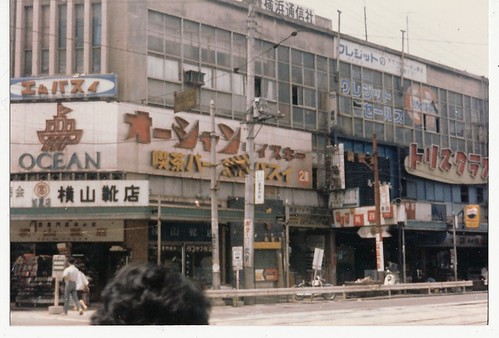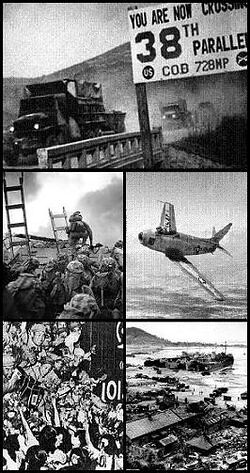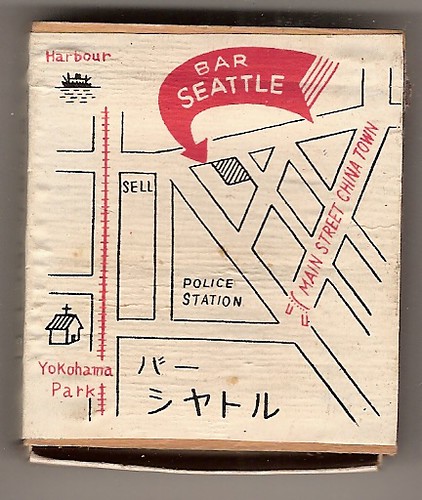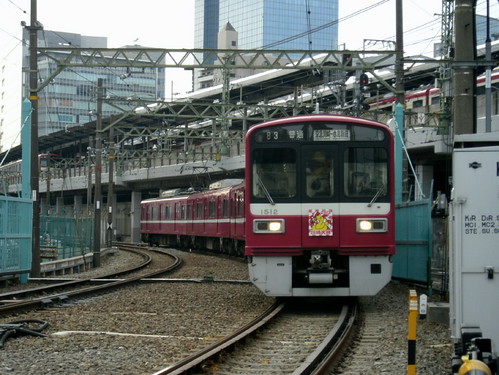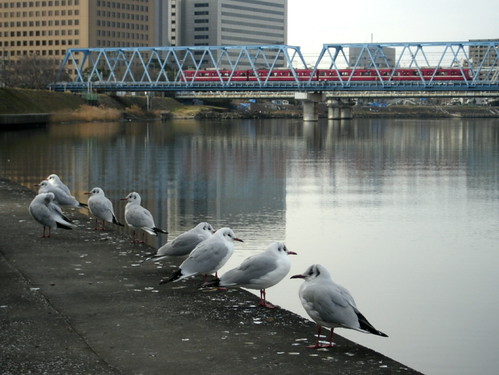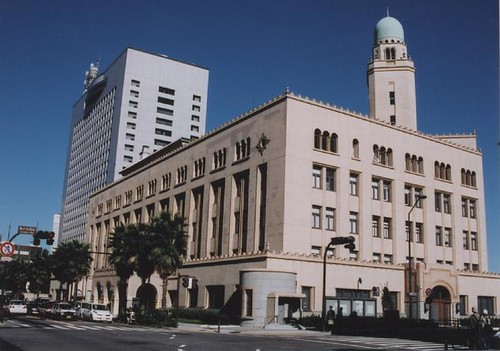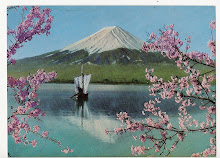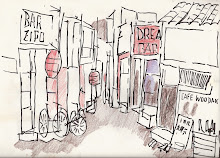Many memories associated with this landmark ship. I would love to live aboard this vessel and maintain a studio. This is just a dream, but one that is full of pleasure.
You have many excellent photographs I enjoy.
YOKOHAMA PICTURE SHOW

Shot with my Petri in Yokohama 1962
RICE FIELD IN JAPAN 1962

I took this with my PETRI in Kanagawa Prefecture
Wednesday, January 30, 2013
横浜 Yokohama 201209
Monday, January 28, 2013
HOT SPOT IN YOKOHAMA 1961 THE PEANUTS CLUB
HOT SPOT IN YOKOHAMA 1961 THE PEANUTS CLUB
NOTE THE PEPSI SIGN. SOMEWHERE IN THIS AREA, THERE WAS A CLUB CALLED "THE PEANUTS" CLUB. NOTE THE VERIFICATION OF SUCH A CLUB IN THE LINK BELOW:
According to the website below, there is a club called "Peanuts" at Isezakicho (伊勢崎町) in Yokohama on around 70's. discotimemachine.com/yokohama.html
Thursday, January 24, 2013
NORTH KOREA THREATENS USA
General MacArthur wanted to neutralize the evil that lurked north of the 38th parallel. Unfortunately, President Truman called the 5-Star General home and relieved him of duty. Look at the difference between COMMUNISM and DEMOCRACY today--look at South Korea and look at North Korea. This is a lesson in freedom and democracy I hope is taught in our schools today. RLH
Imagine what would have happened in Korea if the United States had not stopped the spread of Communism. It should be apparent to all rational and intelligent people of all political persuasions and nationalities what Korea would be today if the United States had not entered the combat and stopped the crimes from spreading south of the 38th parallel. It should be evident what Korea would be today if the United States had left the future of Korea to fate. Take a look at North Korea and the evidence is clearly visible of what happens when selfish, power-hungry men and their compatriots want to rule with an iron hand of socialism. RLH
HISTORY OF KOREA WIKIPEDIA: en.wikipedia.org/wiki/Korean_War
Pacific Kilroy (6 hours ago)
Good point! I tried teaching the difference when I was in public education. I hope I succeeded with some; unfortunately, most are too stupid to find their butt with both hands, and their parents back them up. I also contrasted East and West Germany, Western and Eastern Europe, and Taiwan and China.
Do you want to know something scary/funny but true?
Most kids these days hear about our two political parties, Republican and Democrat, and they are so poorly informed that all they can do is associate the name "Democrat" with democracy. They have been taught that democracy is good and is our form of political system. They then want to support the Democrat party because they truly believe Democrats support democracy. The obvious (to them) reverse is true that Republicans, being against Democrats, must not support democracy which means they are the bad guys. I kid you not - as a public educator in social studies for 20 years!!
THEY CANNOT THINK FOR THEMSELVES, and many of their teachers are just as ignorant. I was always amazed, as a teacher, at how stupid some of my colleagues were!
I used to spend a LOT of time trying to de-program their minds and trying to teach them that FIRST: We are not a democracy but a Republic and that a TRUE democracy can hardly exist. I then make them learn about the Delian League of ancient Greece to see how democracy breaks down into chaos and socialism / Oligarchy. SECOND: The names of the political parties are just names and do not necessarily reflect the political opinions or views that some people might attribute to them.
I then introduced them to Aristotle's political cycle that was augmented (perfected) by Polybius and had them see how the only truly stable government that supported liberty was a conglomeration of forms (checks and balances) that was seen in the Roman Republic and which was reborn in our own Constitution. With a group of halfway bright 14-year-olds, I can have them comprehending this and being truly enthusiastic about our Constitution and personal liberties.
But alas - I am but one teacher who was driven out because he expected too much of his students and refused to compromise when Johnny wouldn't even TRY to read. I was tired of dumbing down our system so that the apathetic idiots could get an A and the smart kids could get perfect scores while asleep. High scores mean that the principals and superintendents get pay bonuses, so which side do you think THEY support?! IT'S ALL ABOUT THE NUMBERS AND THE MONEY! My expression was that "They are pulling an Enron." ...falsifying what was really happening in order to get more people to invest in what is NOT really working. The administrators are the corporate executives who walk away rich - the kids and society are the investors who lose everything.
Result: We have a majority - albeit small - that continue to vote for Obama and his Democrat friends who would erode our freedoms to become like North Korea. Students who were never taught that voting "Democrat" does not mean voting for democracy and their parents, who also know no better, who would sacrifice freedom for the false sense of security that the government will help them or do something for them.
Some, like our president, know exactly what they are doing to this country, but I am convinced that the vast majority, upon whose shoulders he rose to power, are simply too ignorant to understand that they are daily losing their freedoms and doing so at their own bequest.
roberthuffstutter (5 hours ago)
You are an excellent writer.One of the best works I have read explaining why the Democrats have taken the lead politically. Your words perfectly describe how the educators have robbed our youth of the truth.
Perhaps it is by a lack of qualified teachers, but I believe much of this anti-Republican mindset is designed by teachers who have an organized agenda promoting Socialism.
There was a time when the majority of the educators were either part of the "greatest generation" or their immediate offspring. Today, few teachers remember the hardships of WWII or the joys of growing up in the 50s and 60s, eras of very little government interference or impromteau rules and regulations.
Pacific Kilroy (2 hours ago | reply | delete)
Thanks for the accolades. From my own perspective, you are right. There are many teachers out there who are not qualified. But you are also right in your assumption that there is a general trend among educators who seem to promote Socialism. I will not venture to guess why that is the case at this time other than to speculate on a decay of values and education in the home and the lack of a life lesson or trial by fire.
My reason for that statement is this: I am a son of a WWII veteran and a Great Depression child. My parents constantly talked to me and taught me about our own, American, culture and filled me with the pride of being an American. We were poor. I remember being laughed at because I wore homemade shirts to school. I remember being a little excited when we actually had meat with dinner. When I went to college, I had professors that tried to fill me with their hateful attitudes that derided and ridiculed all that is good about America. Because of the foundation my parents had given me, I was able to hear the professors and approach their philosophies with an open mind, therefore, admitting that not everything about this country is perfect and pure. However, I was also well trained enough and knowledgeable enough and had enough common sense to see a bigger picture than the one they were forcing upon the class. I was able to listen respectfully, respond in a way that did not displease the instructor, yet maintain my own beliefs.
Too many young people these days have no beliefs at all. They are not properly parented, in part, because both parents are trying to earn enough money to buy all that happiness that they have been lied to about by the "undercurrent" of our society. So they are complete voids and tend to believe whatever relatively intelligent sounding individual happens to get to them first.
Many teachers in public and private settings are essentially intellectual snobs who have never really DONE anything. Their minds are full of theorems and formulas, but they have no real social experiences with which to "fill in" the blanks. Our teachers of the past were, as you say, part of the Greatest Generation who had real struggles to conquer and whose perseverance caused them to grow in WISDOM as well as knowledge.
Today, we have developed into an instant gratification society where everyone wants to have everything...without a struggle.
The other problem (that really gets my blood boiling) is that we, as a society, no longer value social studies. From the time I was in THIRD GRADE, I can remember people talking about how far behind American kids were compared to other industrialized countries. The reaction: every few years there is a huge push among educators to promote math and science. I have no problem with that, since I have ACTUALLY SEEN students get out a calculator to subtract 2 from 2 (not a joke!). But what I DO have a problem with is the fact that we constantly sacrifice knowledge in social studies for our efforts to improve our industrialized society. In my state, social studies is usually taught by a coach who cares more about his off-season weight lifting program than what his students are or are not learning. But that is sufficient because state standards are so low that kids who can barely write their names SOMEHOW manage to pass a standardized test. The result is that these kids go on to college - where they decide to be coaches but realize they also have to teach something...so they pick the subject they remember as being the easiest - social studies - and become a coach and teacher who perpetuates the problem. Without a firm foundation and knowledge of who we are as a people, how can we possibly develop into an even better society?
Kids these days don't know about the Bataan Death March, for example. I once conducted my own survey of sorts and found that less than 10% of my high school's students ever heard of it, and most associated it with Hitler and the Nazis. I once picked up a history book and turned to the unit on World War II. It had the entire Pacific Theater of the war condensed to one page, BUT it had an entire CHAPTER on Jesse Owens at the Berlin Olympics...as part of World War II!!!
It is frustrating to see that we have already slipped so far that people are ignorant enough of their own culture and freedoms to literally cheer as those liberties are vanquished.
roberthuffstutter (a moment ago)
Your last sentence says it ALL--in my opinion.
"It is frustrating to see that we have already slipped so far that people are ignorant enough of their own culture and freedoms to literally cheer as those liberties are vanquished."
A SHORT STORY: "LET'S GO TO CHINATOWN FOR A FEW DRINKS"
I served with many WWII vets while in the Navy in the 60s. At the time, none of my contemporaries or I expressed much awe or really gave it much thought, we simply enjoyed a few beers together at the EM Club or Non-Com Club and joked about what was happening in Yokohama’s Chinatown.
One of my good friends, Russ, a First Class Aviation Electrician's Mate and I frequently went to Yokohama on the weekends.
We started out drinking at bars near the U.S. Housing area in hopes of meeting some of the girls from the USA who would wonder in looking for dancing partners. So, there we were, me a 19 year-old guy having the time of my life drinking and out chasing women with a WWII vet who had served aboard one of the carriers in the South Pacific. That was in the autumn of 1961. He was only 37, still a young man.
Russ was born in 1924 and if he is still living, he would be around 89. Time flys.
I will never forget the night when Russ and I were in a certain little club in Chinatown and met two young ladies who looked like Mitzi Gaynor and her twin sister.
We asked them what state they were from. They looked at each other and began laughing. Russ told me to get ready for the surprise of my life.
I asked him if they were Admiral’s daughters or something. They were drop-dead gorgeous and looked like they wanted to party. I was hardly able to maintain my self-control.
They said something to Russ in Japanese. He nodded his understanding. I hadn’t realized Russ could speak Japanese and I asked him to tell them to speak English. He laughed.
“Neither of them speak English,” he told me. “They are Japanese,” he said. “Well, sort of,” he added. “Anyway, they are way too young for us,” he said. “They are only 16,” he told me.
They sure didn't look like Japanese girls, they looked like they were American girls, maybe cheerleaders. Not that it mattered, but it was most unusual for a sailor to meet American girls overseas.
Nevertheless, we bought them drinks. Russ told me they were products of the Occupation, their dads were American soldiers and never returned for them–or their mothers. I nodded. It was then that I understood why they spoke very little English.
As the evening wore on, I found that language was no barrier to what turned out to be an extraordinarily delightful night.
When I next saw Russ on Monday morning in the hanger, we smiled . Neither of us asked how our weekends ended, but I think we knew. It wasn't our last trip to a certain little bar in Yokohama's Chinatown.
Sunday, January 20, 2013
JAPANESE WARFARE WITH INVADING MONGOLS
THE MONGOL INVASIONS OF JAPAN
In the 13th century, Kublai Khan, grandson of Genghis Khan and the Mongol Emperor (Yuan Shi-zu) who founded the Yuan Dynasty of China, envisioned to succumb Japan and incorporate it as a tributary state of the Mongol empire. In 1274 and 1281 armies were despatched from the Korean peninsula and China in attempts to land on Japan in today's Fukuoka city area in north Kyushu.
It was so recorded that a thunderstorm harassed north Kyushu island in 1274 when the Mongol (Yuan) army was fighting, and again in 1281 a typhoon hit north Kyushu island while the Yuan soldiers were on board their ships preparing for a major landing operation. In both instances the Yuan armies suffered severe casualties from these natural calamities and the invasions were aborted. These "divine" winds have come to be known as Kamikaze which, especially during the war periods of pre-1945 Japan, has been fostering a belief in Japan in the sacredness of the Japanese nation.
After the first invasion of 1274, the Japanese samurai built a stone barrier of 20 km long bordering the coast of Hakata Bay of today's Fukuoka city. This stone barrier, on which the Japanese soldiers forcefully fought in resistance, effectively prevented the landing of the Yuan (Mongol) army on the shore of Hakata (now in Fukuoka city) during the second invasion of 1281.
The Yuan armies were made up of Mongol, Korean and Chinese soldiers
TEXT AND IMAGE FROM WIKIPEDIA
References cited with image on Flickr Photostream
Thursday, January 17, 2013
ELECTRICITY LIGHTS UP RURAL JAPAN 1900S
ELECTRICITY LIGHTS UP RURAL JAPAN 1900S
The history of when and how the rural areas of Japan hooked up to electric power is long and complicated, a great subject for a college research paper.
Electric Power In Japan
Rapid electrification a century ago
Written by Mitsuyoshi Yamamoto and Mitsugi Yamaguchi
ILLUSTRATION by R.L.Huffstutter
Japan was opened to the world by U.S. Commodore Matthew C. Perry in 1854. Western culture, ideas, and technology soon permeated Japan, contributing to rapid modernization, including the establishment of electric light and power systems. Prof. W.E. Ayrton of the United Kingdom illuminated an electric arc light at a university campus in Japan for the first time in 1878. In 1882, Brush Company of the United States demonstrated lighting with a set of arc lamps in various places in Japan. The Japanese people, admiring the unfamiliar arc lights, said that the brightest light in the world is the sun, followed by the moon, and next the arc light.
In 1883, Tokyo Electric Light Company was founded and, in 1887, began service to the public using Thomas Edison's direct current (dc) system, 25-kW generators, and incandescent lamps. By 1890, more than 5,000 incandescent lamps were lit in Tokyo using power supplied by four power stations (one is shown in Figure 1). Other electric light companies were soon established in many areas of Japan. In 1889, the Electric Light Company in Osaka (the largest business center in the western region) introduced the Thomson-Houston 125-Hz single-phase 30-kW power system. The first hydroelectric power station in Japan, the Keage Power Station, was planned in 1888 in Kyoto City (the ancient capital of Japan near Osaka), and 19 generators were installed by 1897. The generators installed in Japan at that time were of various types because the most advanced equipment was being introduced with each new installation. Examples of these early generators are listed in Table 1.
The Keage Power Station is like a museum, exhibiting dc generators and alternating current (ac) generators with one to three phases and frequencies of 50, 60, 125, and 133 Hz. From the outset over a century ago, Japan introduced the most advanced power systems and machines for electric light and power only a few years later than the West. It was an era of revolutionary technological progress in power systems and remarkable developments in machinery, both in the West and in Japan.
The Era ofDC Power Systems
The commercial dc era began in the early 1880s when Edison demonstrated his "jumbo" bipolar generator to supply power to a dc lighting system. His power system was displayed at the Paris Electrical Exposition in 1881, receiving the highest praise and attracting great interest from foreign enterprises. Edison, taking advantage of this opportunity to increase sales, established subsidiary companies in many places in the United States and in many countries in Europe. It was only natural that Tokyo Electric Light Company, on recognizing the particular merits of Edison's power system, would initiate public utility service based on his idea.
At the Keage Power Station located in the middle of a canal, an inclined plane was placed to provide for the passage of boats. The first two sets of Edison's 80-kW dc generators were used primarily for the power supply to this equipment. This power station was planned according to the survey of the Aspen District in Colorado. In Aspen, there existed a hydraulic power station with dc generators that supplied power to a mining company to lift ore 304.8 m (1,000 ft).
Almost at the same time, the Keage Power Station installed four sets of Thomson-Houston single-phase 125-Hz 60- and 75-kW ac generators to meet the growing demand for light and power. Osaka Electric Light Company introduced the same type of 30-kW generators as well. This indicates that the era of Edison's dc power system ended in Japan after only a few years, beginning the era of ac power systems.
There were many pioneering efforts related to early power systems over the 30-year period before Edison introduced his dc bipolar dynamo. Notable among these efforts were the electromagnetic field for permanent magnets by H. Wilde (United Kingdom), the ring core by Z.T. Gramme (Belgium), the drum coil by F. von Hefner Alteneck (Germany), and the self-excitation dynamo by W. Siemens (Germany). However, further developments were necessary to permit the construction of modern generators. One such development was a multipolar circular magnetic field yoke which held coils in slots that could firmly support rectangular copper conductors. This improved magnetic circuit was used in 1895 when two sets of multipolar dc generators manufactured by General Electric were installed at the Keage Power Station to supply the first streetcars in Japan.
The most serious disadvantage of the early dc power system was the difficulty of changing voltage, the lack of long-distance power transmission capability, and the limited area of power supply. Because of these inherent problems, the dc power system had to yield to ac power systems.
The Era of AC Power Systems
There was debate over the usage of ac versus dc in the United States in the late 1880s and early 1890s. In the end, the supporters of ac were victorious. Manufacturing companies in this group included Westinghouse and Thomson-Houston (later General Electric after the merger with the Edison General Electric Company). In the 1880s, Westinghouse employed single-phase ac at a frequency of 133 Hz. Thomson-Houston supplied single-phase ac equipment operating at 125 Hz. Lighting constituted almost all of the load at that time, and the supply area was small, so the high frequencies of 125 and 133 Hz, advantageous for transformers, was favored. Ten-pole generators rotating at 1,000 rpm with a belt drive could generate power at a frequency of 133 Hz.
In 1886, William Stanley achieved the first United States demonstration of an ac lighting system using transformers at Great Barrington, Massachusetts. With this outcome, George Westinghouse decided to participate in the business of ac power and fabricated five kinds of standard light systems, namely, 500, 750, 1,500, 3,000, and 6,000 lamps with 16 candle power (cp) incandescent lamps. Of these, the 3,000 lamp system was commonly adopted at central power stations. Thomson-Houston's generator had three standard types: A35 (35-kW, 650 lamps), A70 (70-kW, 1,300 lamps), and A140 (140-kW, 2,600 lamps).
In Japan, there was also debate concerning the selection of dc or ac. Both the first generator at Osaka Electric Light Company and the third generator at Keage were operated with ac in 1891. The ac power system involves a danger of high voltage. However, the two companies employed Thomson-Houston single-phase 125-Hz generators, expecting the further development of ac systems and also exhibiting some sense of rivalry against Tokyo where the dc power system was more common at that time. It seems likely that Osaka Electric Light Company installed machine type A35, and Keage type A70.
The single-phase 125- or 133-Hz ac system of the early days became disadvantageous given the need for poly-phase power and lower frequencies. It was recognized that lower frequencies than 125 and 133 Hz would be desirable. While 125 and 133 Hz were somewhat better for transformers, a lower frequency than 60 Hz was considered better for power transmission and for rotary converters. In Europe, generators directly coupled with high-speed reciprocating engines (400–500 rpm) were considered, and such construction was eventually employed in the United States. For this type of generator, a frequency of 60 Hz would be desirable. For example, a 450-rpm, 16-pole generator would generate 60 Hz.
On the other hand, a lower frequency than 25 Hz is not suitable for incandescent lamps due to visible lamp flickering. A compromise between these contradictory conditions eventually led to the adoption of 60 Hz for general-purpose use and 25 Hz for transmission and rotary converters as the standard frequencies in the United States.
Westinghouse invited Nicola Tesla to be a consultant to his company and obtained exclusive rights to Tesla's polyphase ac system after Tesla's 16 May 1888 lecture to the AIEE on "A new system of alternate current motors and transformers." In 1893, Westinghouse won the contract to light the Chicago World's Fair and used this opportunity to display his two-phase universal system which consisted of six 1,000-hp 60-Hz generators, 300-hp induction motors, and rotary converters. This demonstration helped Westinghouse win the contract to build power facilities for the Niagara Falls Project. Westinghouse provided the first three 25-Hz, 5,000-hp, 2.2-kV, 250-rpm two-phase generators that were installed and put into operation at Niagara in 1895. In the following years, the Niagara Falls Project was greatly expanded.
In 1893, General Electric built the United States' first commercial three-phase ac system in Southern California for the Redlands Electric Light and Power Company. Pelton turbines drove two 250-kW hydroelectric generators. The power was transmitted 12.1 km (7.5 mi) to Redlands at 2.4 kV. In 1896, General Electric built a 35.5 km (22 mi) three-phase transmission line operated at 11 kV to transmit power to Buffalo, New York, from the Niagara Falls Project. The two-phase generated power was changed to three-phase by the use of Scott-T transformations.
Westinghouse was known in the 1890s as the advocate of the two-phase ac system, whereas General Electric favored the three-phase system. The primary reason Westinghouse preferred the two-phase system was the fact that almost all of the load was single-phase lighting, and power supply areas were limited in those days. In addition, the circuit was simple and there was merit in having only two transformers. However this situation changed with the widespread use of motors, including induction motors, and the necessity of long-distance transmission. As a result, three-phase systems came to dominate the power system market.
Another manufacturer, Stanley Electric Manufacturing Company, produced a two-phase ac system that was applied to the distribution of light and power at frequencies as high as 133 Hz. The generator was an inductor type with two-stator armature windings displaced by 90. The Keage Power Station introduced a two-phase Stanley system in 1894 to meet the power demand of light industries such as spinning, silk textile, metal foil working, and tobacco. These generators soon became obsolete, and three-phase replacement generators were imported in 1896 and 1897 from Siemens and General Electric.
Tokyo Electric Light Company introduced six three-phase, 50-Hz, 265-kW, 3-kV, 150-rpm generators in 1896 from Allgemeine Elektrizitäts Gesellschaft (AEG) in Germany and then, in 1896 and in 1897, Keage Power Station introduced three-phase, 60-Hz, 100- and 150-kW generators from General Electric and four three-phase, 50-Hz, 80-kW generators from Siemens.
Tuesday, January 15, 2013
GEDC1020
WHAT A MASTERPIECE. This is of the best I have seen.
____________________________________
GEDC1020 by mr_nihei
GEDC0973
Birds of this feather I have not seen for more than 50 years if these birds are seen only in Japan.
They look unique and fit into the scene and scheme of the city quite well.
This is a photo I like quite well, the red train speeding to or from the city's center, the river, the nine birds of a feather enjoying their small space beside the Tama River.
It took a photographer of note to notice such a scene that would pass most people by with never so much as a glance.
In this image is preserved a moment in time faraway from where I am, but a place where I have been, a joy to remember. It is a scene I want to see again someday soon. RLH
____________________________________
GEDC0973 by mr_nihei
Saturday, January 12, 2013
8th Army HQs
PHOTO BY MY FRIEND KOJI KANEMOTO
I am hoping to see this building once again before it is razed. It is a landmark for the memories of many who passed this way at sometime in their lives. It is a fond reminder for me; I painted many scenes of this building while in Yokohama, most given away to whomever was passing by at the time. I can honestly say that the smiles and thanks I received are still vivid in my mind and have lasted so much longer than the yen offered in exchange but which I politely declined. I'm hoping that some of the work I gave away is framed and hanging on the walls of some of Yokohama's homes. In some instances, I was asked to pose with my paintings.
_____________________________________
8th Army HQs by Mustang Koji





